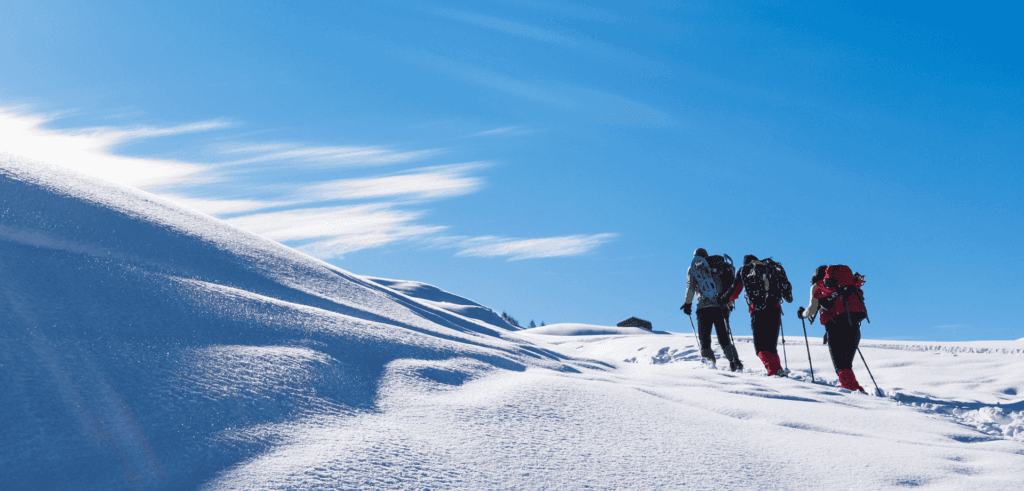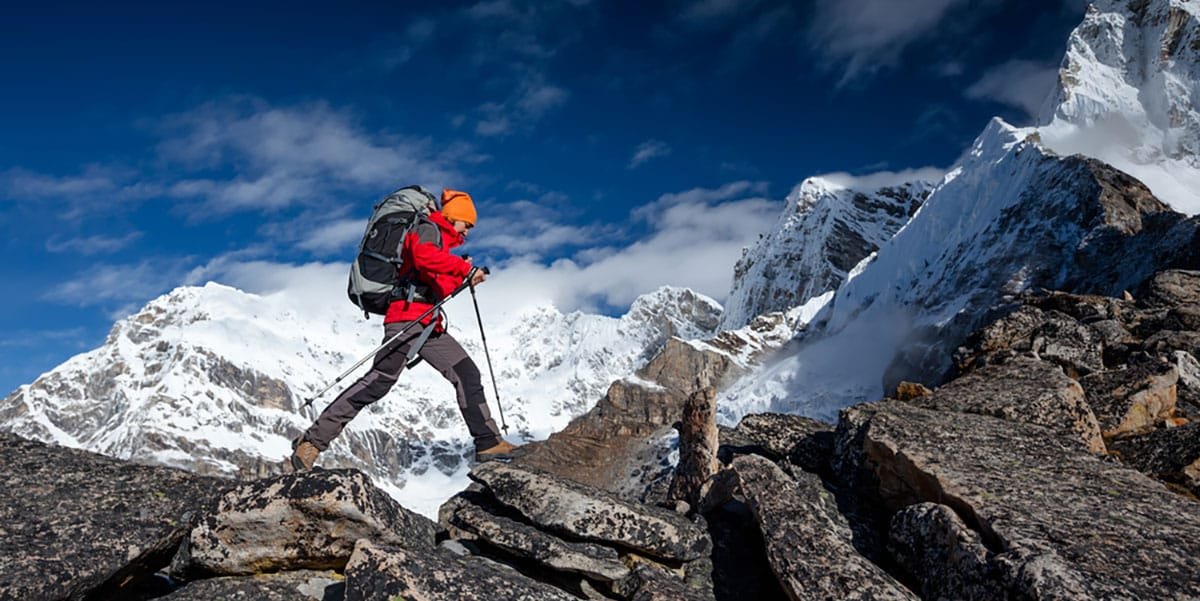
What is High Altitude Sickness?
High Altitude Sickness, also known as Altitude Sickness, is a serious condition that occurs when your body struggles to adapt to lower oxygen levels at elevations above 8,200 feet (2,500 meters). This condition can lead to serious health complications and, in severe cases, life-threatening situations if not managed properly. Understanding this urgency is crucial for your safety.
This guide will cover the different types of altitude sickness, the medical conditions that may increase the risk, and effective prevention strategies. It will also discuss available medications, their role in preventing altitude sickness, and their potential side effects. The goal is to provide essential information on altitude sickness, including its symptoms and prevention methods, to help you prepare for high-altitude treks or Expeditions.
Before embarking on your Adventure, it is crucial to consult your doctor for personalized medical advice based on your health condition. Proper preparation and awareness, which are key to reducing the risks associated with high-altitude travel, can empower you and make you feel in control of your journey.
Types of High Altitude Sickness:
High Altitude Sickness is categorized into three main types, each varying in severity and requiring different treatment approaches. Below is a detailed overview of each type, including causes, symptoms, and treatment methods.
1. Acute Mountain Sickness (AMS)
2. High Altitude Cerebral Edema (HACE)
3. High Altitude Pulmonary Edema (HAPE)
Acute Mountain Sickness (AMS)
AMS is the most common form of altitude sickness, typically appearing within 6 to 24 hours of reaching a high altitude. The symptoms closely resemble those of a hangover, but it’s important to remember that AMS can escalate if not managed properly.
Symptoms AMS:
- Headache – A persistent, throbbing headache that worsens with exertion.
- Nausea and vomiting – Feeling sick to the stomach, sometimes leading to vomiting.
- Dizziness or lightheadedness – A sensation of unsteadiness or faintness.
- Fatigue and weakness – Unusual tiredness, even with minimal effort.
- Shortness of breath – Difficulty breathing, especially with activity.
- Loss of appetite – Reduced desire to eat, often accompanied by nausea.
- Difficulty sleeping – Trouble falling or staying asleep at high altitudes.
Causes and Risk Factors of AMS:
AMS occurs due to reduced oxygen levels at high altitudes. The primary risk factors include rapid ascent without proper acclimatization, intense physical activity soon after arrival, and individual susceptibility.
Rapid Ascent – Climbing to high altitudes too quickly prevents the body from adapting to lower oxygen levels.
Lack of Acclimatization – Failure to spend enough time at intermediate altitudes before ascending higher increases the risk.
Physical Exertion at High Altitudes – Strenuous activity can worsen symptoms by increasing oxygen demand in body.
High Altitude Exposure – The risk rises above 2,500 meters (8,200 feet), where oxygen levels drop significantly.
Pre-existing Health Conditions – Individuals with heart, lung, or respiratory diseases are more vulnerable to AMS.
Dehydration – Inadequate fluid intake can worsen symptoms by reducing blood circulation and oxygen delivery.
Obesity – Excess weight may strain breathing and circulation, making acclimatization harder.
Previous AMS Experience – Those who have had AMS before are at higher risk of recurrence.
Alcohol & Sedatives Use – These depress the respiratory system, making it harder for the body to adapt to low oxygen levels.
Genetic Susceptibility – Some individuals are naturally more prone to altitude sickness due to genetic factors.
Preventing and Treating Acute Mountain Sickness (AMS):
Preventing and Treating Acute Mountain Sickness (AMS) involves gradually increasing altitude, staying well-hydrated, avoiding alcohol and sedatives, resting when symptoms arise, considering the use of Acetazolamide (Diamox), consuming a high-carb diet, dressing appropriately for the weather, monitoring oxygen levels, and descending to a lower altitude if necessary to alleviate symptoms.
Gradually ascend: Climb higher slowly, giving your body enough time to get used to lower oxygen levels.
Stay well-hydrated: Drink plenty of fluids to avoid dehydration, which can make AMS symptoms worse.
Refrain from alcohol and sedatives: These substances can hinder breathing and the body’s ability to adjust to high altitudes.
Rest if symptoms show: Stop climbing and let your body recover before continuing to higher elevations.
Consider using Acetazolamide (Diamox) : This medication can help accelerate acclimatization by enhancing oxygen intake.
Follow a high-carbohydrate diet: Carbs offer a reliable energy source and support oxygen levels.
Dress appropriately: Keep warm and shield yourself from harsh weather to minimize strain on the body.
Monitor oxygen level : Utilize pulse oximeters, if possible, to monitor oxygen saturation and detect early signs of trouble.
Descend to lower altitude if necessary: If symptoms persist or worsen, descending to a lower altitude is the most effective course of action.
High Altitude Cerebral Edema (HACE)
High Altitude Cerebral Edema (HACE) is a life-threatening condition caused by severe swelling of the brain due to a lack of oxygen at high altitudes. It is an advanced and dangerous form of Acute Mountain Sickness (AMS) and typically occurs at elevations above 3,500 meters (11,500 feet). If untreated, HACE can lead to coma and death within hours or days.
Symptoms HACE:
- HACE symptoms often develop after severe AMS and may include:
- Severe Headache – Intense and persistent, often resistant to painkillers.
- Confusion and Disorientation – Difficulty thinking, making decisions, or recognizing surroundings.
- Loss of Coordination (Ataxia) – Unsteady walking, trouble balancing, and clumsiness.
- Slurred Speech – Difficulty speaking clearly, similar to alcohol intoxication.
- Hallucinations and Irrational Behavior – Seeing or hearing things that aren’t there, unusual emotional reactions.
- Extreme Fatigue and Weakness – Struggling to perform even simple tasks.
- Drowsiness and Coma – Progressive loss of consciousness, potentially leading to coma and death.
Causes and Risk Factors of HACE:
HACE is diagnosed based on symptoms and the patient’s altitude exposure. A key test is the heel-to-toe walking test – if a person cannot walk in a straight line due to poor coordination, HACE is likely developing.
Dehydration and Poor Nutrition – Inadequate hydration and low energy intake can impair the body’s ability to adjust.
Severe Hypoxia (Low Oxygen Levels) – At high altitudes, oxygen levels decrease, leading to inadequate oxygen supply to brain.
Increased Brain Swelling (Edema) – Fluid leaks into brain tissues, causing swelling and increased pressure inside the skull.
Rapid Ascent – Climbing too quickly without allowing time for acclimatization significantly increases the risk.
Physical Exertion at High Altitudes – Overexertion in a low-oxygen environment worsens symptoms.
Preventing and Treating Acute Mountain Sickness (HACE):
Gradual Ascent – Increase altitude slowly, allowing time for acclimatization.
Stay Hydrated & Eat Well – Proper nutrition and hydration support acclimatization.
Limit Physical Exertion – Avoid excessive strain at high altitudes.
Recognize Early Symptoms of AMS – If AMS symptoms appear, do not ignore them—stop ascending or descend if they worsen.
Use Acetazolamide (Diamox) & Dexamethasone – These medications help prevent severe altitude sickness in high-risk.
Supplemental Oxygen – If available, administer high-flow oxygen to improve brain oxygenation.
Dexamethasone (Corticosteroids) – A life-saving drug that reduces brain swelling and inflammation.
Portable Hyperbaric Chamber (Gamow Bag) – A pressurized bag that simulates lower altitudes to stabilize the patient temporarily.
Avoid Further Ascent – The person should not continue climbing, even after recovery.
Note: HACE is a medical emergency that requires immediate descent and treatment to prevent fatal consequences. Early recognition of symptoms, gradual ascent, and proper acclimatization are the best ways to avoid this dangerous condition.
High Altitude Pulmonary Edema (HAPE)
High Altitude Pulmonary Edema (HAPE) is a life-threatening condition in which fluid accumulates in the lungs due to exposure to high altitudes. It is the most common cause of altitude-related deaths and typically occurs at elevations above 2,500–3,000 meters (8,200–9,800 feet). Unlike High Altitude Cerebral Edema (HACE), which affects the brain, HAPE primarily impacts the lungs and can rapidly lead to respiratory failure if untreated.
Symptoms HAPE:
- Symptoms usually appear within 2 to 4 days after arriving at high altitude and worsen if ascent continues:
- Shortness of Breath (Dyspnea) – Initially with exertion, then even at rest.
- Persistent Cough – Dry or with frothy, pink-tinged sputum (a sign of fluid in the lungs).
- Chest Tightness or Pain – Discomfort in the chest, especially when breathing deeply.
- Extreme Fatigue and Weakness – Feeling unusually exhausted, even with minimal movement.
- Bluish Skin (Cyanosis) – Lips, fingers, or face may turn blue due to lack of oxygen.
- Rapid Heart Rate (Tachycardia) – The heart beats faster to compensate for low oxygen levels.
- Gurgling or Crackling Sounds in Lungs – Fluid buildup can be heard when breathing.
Causes & Risk Factors of HAPE:
HAPE develops due to excessive pressure in the lung’s blood vessels, causing fluid leakage into the air sacs. Key causes include:
Genetic Susceptibility – Some individuals are naturally more prone to developing HAPE.
Low Oxygen Levels (Hypoxia) – Reduced oxygen at high altitudes forces the body to constrict lung blood vessels, increasing pressure.
Rapid Ascent – Climbing too quickly without allowing time for acclimatization increases the risk.
Overexertion at High Altitudes – Intense physical activity increases oxygen demand, worsening symptoms.
Cold Exposure – Cold temperatures cause further blood vessel constriction, worsening fluid buildup.
Pre-existing Lung Conditions – People with lung diseases or pulmonary hypertension are at higher risk.
Preventing and Treating Acute Mountain Sickness (HAPE):
Immediate descent to a lower altitude is the most effective treatment. Oxygen therapy is essential, and medications like nifedipine (a calcium channel blocker) or dexamethasone can help reduce pulmonary pressure and ease symptoms.
Immediate action is critical to prevent respiratory failure and death:
Avoid Further Ascent – The person should not climb higher, even after recovery.
Rapid Descent – The most effective treatment is descending at least 1,000 meters (3,300 feet) immediately.
Supplemental Oxygen – High-flow oxygen therapy can stabilize the patient.
Rest & Minimize Physical Activity – Avoid exertion to reduce oxygen demand.
Nifedipine (Medication for Lung Pressure) – Helps lower lung blood pressure and prevent further fluid leakage.
Portable Hyperbaric Chamber (Gamow Bag) – Temporarily simulates lower altitude conditions for treatment in remote locations.
What Increase Risk of High Altitude Sickness (HAS)
Certain medical conditions can significantly increase the risk of high altitude sickness (HAS) and its severity. These underlying health issues can worsen symptoms, potentially leading to life-threatening complications. Suppose you have any of the conditions listed below. In that case, avoid high-altitude travel or consult a qualified doctor before embarking on an altitude-challenging Adventure or trip. A medical certificate from a healthcare professional is strongly recommended in such cases.
1. Asthma & Chronic Obstructive Pulmonary Disease (COPD)
Individuals with asthma or COPD are at a heightened risk of altitude sickness due to reduced oxygen levels, dry air, and cold temperatures at higher elevations. These conditions can trigger bronchospasms (tightening of the airways), leading to difficulty in breathing and worsened symptoms. High-altitude travel is not recommended for those with severe respiratory conditions.
2. Cardiovascular Disease
If you suffer from hypertension (high blood pressure) or coronary artery disease, your heart will struggle to pump blood efficiently at high altitudes where oxygen levels are low. This increases stress on the heart, potentially leading to life-threatening complications such as heart attacks or strokes. Individuals with pre-existing heart conditions should avoid high-altitude destinations unless medically cleared by a doctor.
3. Anemia
Anemia is a condition characterized by low hemoglobin levels in the blood, reducing the body’s ability to transport oxygen efficiently. Since high-altitude environments already have lower oxygen levels, anemic individuals may experience severe breathlessness, dizziness, and extreme fatigue, making acclimatization much more difficult. Check your hemoglobin levels before planning high-altitude travel.
4. Sleep Apnea & Insomnia
Individuals with sleep apnea or chronic insomnia may experience worsened symptoms at high altitudes due to disrupted breathing patterns and reduced oxygen intake while sleeping. High-altitude conditions can lead to poor sleep quality, increased fatigue, and oxygen deprivation, further exacerbating altitude sickness symptoms.
5. Diabetes
People with diabetes face unique challenges when traveling to high-altitude locations. Altitude exposure can impact metabolism, causing fluctuations in blood sugar levels, increased fatigue, and physical stress. Cold temperatures and changes in diet can further complicate glucose management, making high-altitude travel risky for diabetic individuals unless carefully monitored.
Medications, Treatment, Dosages, and Usage
Altitude sickness can be effectively managed with proper medication, preventive strategies, and supportive therapies. Various medications are available, each serving a specific purpose, depending on the severity of the condition. These drugs should be administered cautiously, following proper dosage guidelines and understanding their potential side effects. Below is a comprehensive guide to medications used for treating Acute Mountain Sickness (AMS), High Altitude Pulmonary Edema (HAPE), and High Altitude Cerebral Edema (HACE).
a. Diamox – First-Line Medication for AMS Prevention & Treatment
Acetazolamide (Diamox) is the most commonly prescribed medication for preventing and treating Acute Mountain Sickness (AMS). It works by increasing the blood’s acidity, stimulating breathing, and improving oxygen delivery to the body. By accelerating acclimatization, it helps climbers adjust more quickly to high-altitude environments.
Dosage Guidelines:
Prevention: 125 mg to 250 mg twice daily, starting 2 days before ascent and continuing for two days after reaching high altitude.
Treatment: 250 mg every 8–12 hours until symptoms resolve.
Side Effects:
Tingling sensation in fingers, toes, and face (paresthesia).
Frequent urination (diuretic effect).
Mild drowsiness and dizziness.
Metallic taste in the mouth.
Precautions:
People allergic to sulfa drugs should avoid acetazolamide.
It is not a substitute for proper acclimatization—climbers should ascend gradually.
B. Dexamethasone – For Severe AMS & HACE Treatment
Dexamethasone is a corticosteroid that reduces swelling in the brain caused by fluid accumulation. It is highly effective in treating High Altitude Cerebral Edema (HACE) and is sometimes used for severe AMS. It does not accelerate acclimatization but provides temporary relief until descent is possible.
Dosage Guidelines:
For HACE: 4 mg every 6 hours (oral or injectable).
For severe AMS: 4 mg every 6 hours.
Side Effects:
Increased appetite.
Sleep disturbances (insomnia).
Mood swings and irritability.
Elevated blood sugar levels (concern for diabetics).
Precautions:
Dexamethasone should not be used long-term as it only suppresses symptoms, not treat the underlying cause.
Patients should still descend to lower altitudes as soon as possible.
C. Nifedipine – Primary Drug for HAPE Treatment
Nifedipine is a calcium channel blocker used to treat High Altitude Pulmonary Edema (HAPE). It works by relaxing the blood vessels in the lungs, reducing pulmonary artery pressure, and preventing fluid leakage into lung tissues.
Dosage Guidelines:
- Treatment for HAPE: 30 mg every 12 hours (slow-release formulation).
Side Effects:
- Flushing (warmth in the face and skin).
- Dizziness and lightheadedness.
- Low blood pressure (hypotension), causing faintness.
Precautions:
- It should only be used in cases of confirmed HAPE.
- It does not replace oxygen therapy or descent—these remain the primary treatments.
D. Aspirin & Ibuprofen – For Headache Relief
Both aspirin and ibuprofen are non-steroidal anti-inflammatory drugs (NSAIDs) used to relieve headaches associated with mild AMS. They do not help in acclimatization but provide symptomatic relief.
Dosage Guidelines:
- Aspirin: 325 mg every 4–6 hours as needed.
- Ibuprofen: 400 mg every 4–6 hours as needed.
Side Effects:
- Stomach irritation and potential ulcers.
- Bleeding issues (should be avoided in those with bleeding disorders).
- Kidney impairment (with prolonged use).
Precautions:
- It should be taken with food to prevent gastric irritation.
- Should not be overused—focus on proper acclimatization rather than excessive medication.
5. Oxygen Therapy
Oxygen therapy is the most effective treatment for all forms of altitude sickness. It works by rapidly increasing oxygen saturation in the blood, thereby reducing symptoms and preventing fatalities.
Usage:
- Administered using an oxygen mask or portable oxygen tank to boost oxygen levels in the body immediately.
- Often used in combination with descent to a lower altitude for best results.
Who Needs Oxygen Therapy?
- Individuals with moderate to severe AMS who are struggling to breathe.
- Patients suffering from HAPE or HACE who need immediate relief before evacuation.
Preventive Measures & Non-Medical Interventions
Besides medical treatments, non-medical strategies are vital in preventing and managing altitude sickness. These measures reduce the risk of HAS and enhance acclimatization, allowing for a safer and more enjoyable experience at high altitudes.
1. Gradual Ascent
The golden rule for altitude sickness prevention is ascending gradually.
- Climb 300 to 500 meters per day once above 2,500 meters.
- Rest for a full day after every 1,000 meters of ascent to allow your body to adjust.
- Avoid rapid ascents, as they increase the risk of AMS, HAPE, and HACE.
2. Acclimatization & Rest
Proper acclimatization is crucial for adapting to reduced oxygen levels.
- Spend a few extra days at a moderate altitude (e.g., a base camp) before moving higher.
- Engage in light activities to help your body adjust without overexertion.
3. Stay Hydrated
- Drink at least 3-4 liters of water daily to stay hydrated.
- Avoid overhydration, as excessive water intake can lead to hyponatremia (low sodium levels), causing weakness and confusion.
4. Avoid Alcohol & Smoking
- Alcohol depresses respiration, reducing oxygen intake.
- Smoking decreases the oxygen-carrying capacity of the blood, making altitude sickness worse.
- Avoid both at least 48 hours before ascent and throughout the trip.
5. Maintain Physical Fitness
A healthy body adapts better to altitude changes.
- Regular cardiovascular exercise (hiking, jogging, cycling) before the trip helps improve lung capacity.
- However, avoid intense physical exertion immediately after reaching high altitude.
6. Proper Nutrition & Diet
- Carbohydrates are the best energy source at high altitudes.
- Consume small, frequent meals throughout the day to maintain energy levels.
- Avoid heavy, fatty meals as they require more oxygen to digest.
7. Use of Portable Hyperbaric Chambers
A portable hyperbaric chamber (Gamow Bag) can simulate descent by increasing ambient pressure, making more oxygen available to the body.
- Used in remote areas where immediate descent is not possible.
- It is particularly effective for HAPE and HACE patients who need stabilization before evacuation.
THE TRAVEL FOOT RECOMMENDATIONS
- If you experience mild altitude sickness, descend slightly and allow time for acclimatization.
- If symptoms worsen or do not improve, seek medical attention immediately.
- Always carry the necessary medications and consult your doctor before taking any drugs if you have pre-existing conditions.
- Listen to your body, and don’t ignore early signs of altitude sickness.
By following these medical and non-medical precautions, travelers can safely enjoy high-altitude destinations like Everest Base Camp or other high passes in the trek while minimizing the risks associated with altitude sickness.




